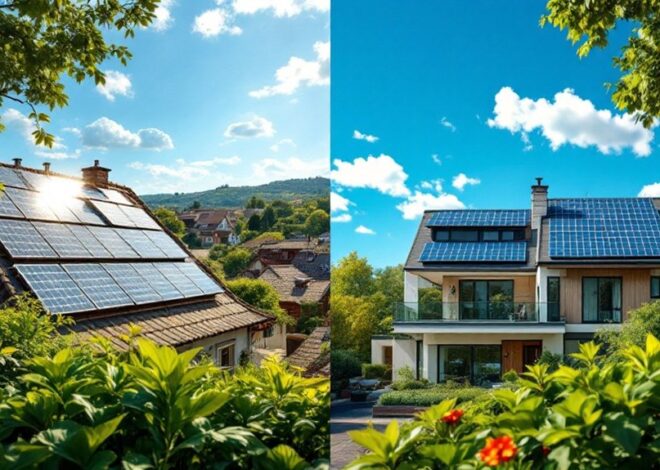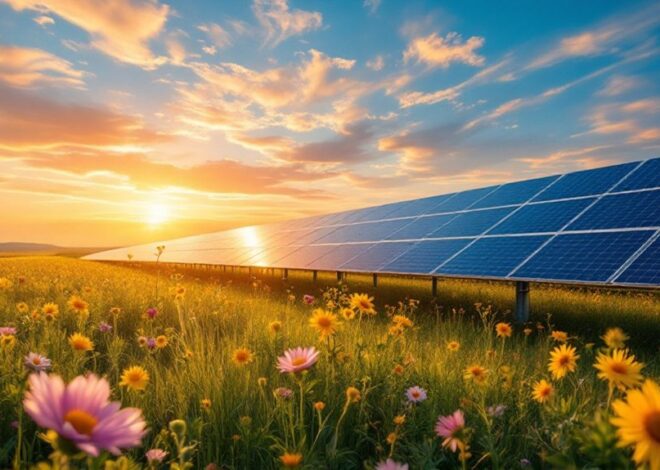
Solar Vs Traditional Energy: What’s Best?
The debate between solar energy and traditional energy sources is increasingly relevant in today’s world. Both options present distinct advantages and challenges. Solar energy is often lauded for its sustainability and potential long-term savings. In contrast, traditional energy sources provide reliability at a lower initial cost. However, the environmental impact of these conventional methods raises questions. As the discussion unfolds, the implications of each choice become more apparent, prompting a closer examination of their roles in our future energy landscape.
Understanding Solar Energy
Solar energy harnesses the power of the sun to generate electricity, representing a renewable and sustainable energy source. This form of energy is captured through solar panels, which convert sunlight into usable electrical power. These panels consist of photovoltaic cells that absorb sunlight and produce direct current (DC) electricity. An inverter then transforms this DC electricity into alternating current (AC) for home and business use. Solar energy systems can be grid-tied, allowing users to draw from the public electricity grid when needed, or off-grid, enabling complete energy independence. The technology has evolved considerably, leading to increased efficiency and reduced costs. Understanding solar energy involves recognizing its components, mechanisms, and the potential for widespread adoption in various applications worldwide. Additionally, renewable energy sources are vital for reducing greenhouse gas emissions and combating climate change.
The Benefits of Solar Energy
As energy demands continue to rise, the benefits of solar energy become increasingly apparent. Solar energy is renewable, harnessing the sun’s power, which is abundant and inexhaustible. This clean energy source considerably reduces greenhouse gas emissions, contributing to a healthier environment. In addition, solar energy can lower electricity bills, as homeowners can generate their own power, reducing reliance on traditional energy sources. Technological advancements have led to increased efficiency and affordability of solar panels, making them more accessible to consumers. Moreover, solar energy systems can enhance property value, appealing to environmentally conscious buyers. Overall, the shift to solar energy offers economic, environmental, and social advantages, positioning it as a viable alternative in the quest for sustainable energy solutions. Additionally, reducing energy consumption through solar energy contributes to lower utility bills and a smaller carbon footprint.
The Limitations of Solar Energy
Despite its advantages, solar energy has notable limitations that can impact its effectiveness. High initial costs for installation can deter potential users, while reliance on weather conditions can lead to inconsistent energy generation. These factors highlight the challenges that must be addressed for solar power to become a more viable alternative to traditional energy sources. Additionally, organizations must proactively address communication barriers to ensure a smooth transition to renewable energy solutions.
High Initial Costs
The high initial costs associated with solar energy installations present a considerable barrier to widespread adoption. While solar technology has advanced, reducing costs over time, the upfront investment remains substantial compared to traditional energy sources. Homeowners and businesses often face expenses related to purchasing solar panels, inverters, mounting systems, and installation labor. Additionally, the financial burden can be exacerbated for those in lower-income brackets, deterring them from considering solar as a viable option. Although financing options and government incentives may mitigate some of these costs, the perception of solar energy as a luxury can persist. This economic hurdle limits solar energy’s accessibility, hindering its potential to contribute considerably to a sustainable energy future.
Weather Dependency Issues
Weather dependency poses a significant challenge for solar energy systems, impacting their reliability and efficiency. Solar panels generate electricity primarily during sunny days, which limits their output during cloudy, rainy, or snowy weather. This variability can lead to inconsistent energy production, requiring supplemental energy sources or storage solutions to guarantee a constant power supply. Additionally, seasonal changes can exacerbate these issues, as shorter days in winter result in reduced sunlight exposure. While advancements in energy storage technologies aim to mitigate these limitations, they introduce additional costs and complexities. In contrast, traditional energy sources, such as fossil fuels, offer consistent and controllable output regardless of weather conditions, highlighting a vital difference between solar and conventional energy systems.
Overview of Traditional Energy Sources
Traditional energy sources, primarily derived from fossil fuels, have long been the backbone of global energy production. This category includes coal, oil, and natural gas, which are extracted and processed to generate electricity and power various industries. Coal, once the dominant energy source, is now facing increased scrutiny due to its environmental impact. Oil remains essential for transportation and heating, while natural gas is often promoted as a cleaner alternative among fossil fuels. Traditional sources also encompass nuclear energy, which, while not a fossil fuel, contributes considerably to the energy mix. As these sources continue to supply a substantial portion of global energy needs, their reliance raises concerns about sustainability, environmental degradation, and the long-term implications for climate change. The concentration of power in the hands of a few energy corporations can also exacerbate these issues, leading to increased economic inequality and resistance to necessary reforms.
Advantages of Traditional Energy
Reliance on traditional energy sources offers several advantages that have contributed to their longstanding dominance in the global energy landscape. First, these sources, such as coal, oil, and natural gas, provide a stable and reliable supply of energy, ensuring consistent availability to meet demand. Additionally, the existing infrastructure for extraction, transportation, and distribution is well-established, facilitating efficient energy delivery. Traditional energy sources typically have lower initial capital costs compared to renewable alternatives, making them economically attractive for many regions. Moreover, advancements in technology have improved the efficiency of fossil fuel extraction and utilization, maximizing output. Finally, traditional energy sources support numerous jobs and economic activities in various sectors, reinforcing their importance in global economies. Furthermore, these industries are integral to online reputation management as they often rely on public perception and trust to maintain their market positions.
Disadvantages of Traditional Energy
Although traditional energy sources have been the backbone of global energy systems, they come with significant disadvantages that raise concerns about sustainability and environmental impact. Fossil fuels, such as coal, oil, and natural gas, are leading contributors to greenhouse gas emissions, exacerbating climate change and air pollution. The extraction and processing of these resources often result in habitat destruction and soil contamination, posing risks to biodiversity and ecosystem health. Additionally, reliance on finite resources creates energy security issues, as depletion rates escalate. The infrastructure required for traditional energy production is often costly and can lead to environmental degradation. As the world shifts toward more sustainable practices, the limitations of traditional energy sources become increasingly apparent, prompting a search for cleaner alternatives.
Comparing Costs: Solar Vs Traditional
The cost comparison between solar energy and traditional energy sources reveals significant differences that impact decision-making for consumers and policymakers alike. Solar energy systems generally involve a higher upfront investment, primarily due to the cost of photovoltaic panels and installation. However, operational costs for solar are typically lower since sunlight is free, leading to long-term savings on electricity bills. In contrast, traditional energy sources, such as coal and natural gas, may have lower initial costs but often come with fluctuating fuel prices and additional expenses related to environmental regulations. Additionally, government incentives for solar adoption can offset initial costs, making solar increasingly competitive. Ultimately, the financial implications play an essential role in the shift toward renewable energy sources.
The Future of Energy: A Balanced Perspective
The future of energy hinges on a careful evaluation of renewable energy‘s potential alongside traditional sources. By comparing their environmental impacts, one can better understand the trade-offs and benefits of each approach. This balanced perspective is essential for shaping sustainable energy policies moving forward.
Renewable Energy Potential
As the world increasingly confronts the consequences of climate change, the potential of renewable energy sources emerges as a critical component in shaping a sustainable future. Innovations in solar, wind, hydro, and geothermal technologies showcase the capacity to harness natural resources effectively. Solar energy, in particular, has seen remarkable advancements, leading to increased efficiency and reduced costs. Wind power continues to expand, contributing considerably to energy grids worldwide. Additionally, governments and organizations are investing in research and development to reveal new methodologies for energy storage and distribution. The shift towards renewable energy not only promises to meet the growing energy demands but also aims to create a more resilient and environmentally friendly energy infrastructure, ensuring a balanced approach to global energy needs.
Environmental Impact Comparison
Comparing the environmental impacts of solar and traditional energy sources reveals significant differences in sustainability and ecological footprint. Solar energy, harnessed from the sun, generates electricity without harmful emissions, contributing positively to air quality and reducing greenhouse gas emissions. In contrast, traditional energy sources, such as coal and natural gas, release significant carbon dioxide and pollutants during extraction and combustion, damaging ecosystems and human health. Moreover, solar energy systems often require less land and water compared to fossil fuel extraction processes, which can lead to habitat destruction and resource depletion. Overall, the shift towards solar energy presents a more environmentally friendly alternative, promoting long-term ecological balance and sustainability while addressing the urgent need to mitigate climate change impacts associated with traditional energy sources.
Frequently Asked Questions
How Long Does It Take to Install Solar Panels?
The installation duration for solar panels typically ranges from one to three days, depending on system size and complexity. Factors such as weather, permitting, and site preparation can also influence the overall timeline considerably.
What Incentives Are Available for Solar Energy Installation?
Various incentives exist for solar energy installation, including federal tax credits, state rebates, and local grants. These financial incentives aim to reduce installation costs, promote renewable energy adoption, and encourage environmentally sustainable practices among homeowners and businesses.
Can Solar Panels Work in Cloudy Weather?
The effectiveness of solar panels in cloudy weather is notable; they can still generate electricity, albeit at reduced efficiency. Factors such as panel quality and cloud density influence their performance during overcast conditions.
How Do I Maintain Solar Panels?
Maintaining solar panels involves regular cleaning to remove dust and debris, checking for shading issues, and inspecting connections. Periodic professional assessments guarantee peak performance, while monitoring energy output helps identify potential problems early.
What Happens to Solar Panels After Their Lifespan?
After their lifespan, solar panels are typically recycled or disposed of in landfills. Recycling recovers valuable materials, while improper disposal can lead to environmental hazards. Proper management of old panels is essential for sustainability.
Conclusion
To summarize, the comparison between solar and traditional energy sources highlights the advantages of solar energy as a sustainable and eco-friendly alternative. While initial installation costs may deter some, the long-term savings and environmental benefits present a compelling case for solar adoption. Conversely, traditional energy sources, though reliable and cost-effective upfront, contribute to environmental issues. As society seeks a healthier future, embracing renewable energy like solar is essential for achieving energy independence and reducing greenhouse gas emissions.



